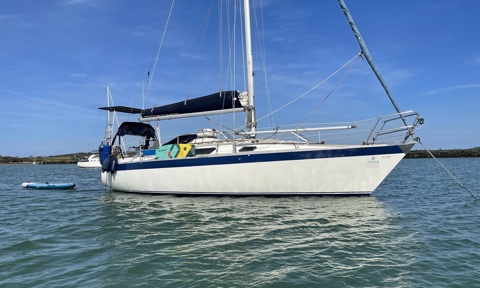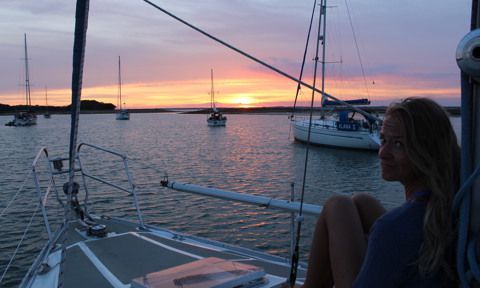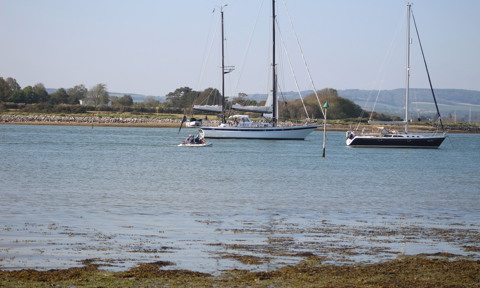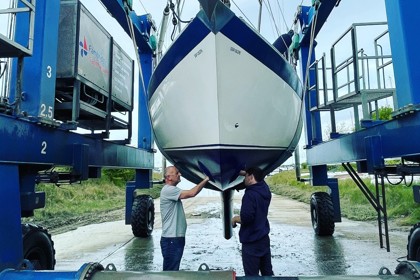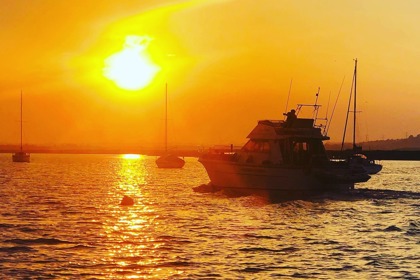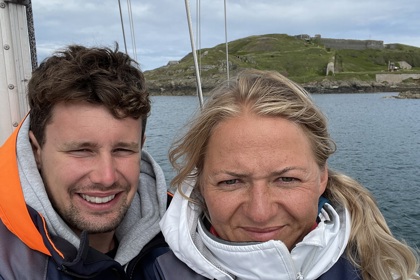Sharing their onboard experiences and top tips
We've partnered up with experienced mariner Steve and new-to-sailing Inga who are exploring the coast on their Dolphin 31, Jasper. While travelling, Inga and Steve are sharing their experiences and providing top tips for fellow boaters.
Their fifth blog is all about sharing advice about how to choose a suitable anchorage, anchoring tips and some of their favourite destinations around the Solent.
The Solent is packed with a fantastic choice of destinations to suit every occasion.
The protected waters between the South of England and Isle of Wight provide an exclusive sailing experience suitable for new and experienced sailors. In addition, the Solent is rich in natural beauty, unspoiled nature, and peaceful places where inquisitive sailors can drop an anchor.

Being at Anchor
Anchoring provides a sense of freedom that often can't be accessed in a marina. Being on the anchor can be very relaxing when you find a quiet spot and the weather conditions are right. Our sailing adventure's goal was to drop the hook and spend time in the less known and unspoiled channels and rivers while sailing the Solent, where wildlife is more commonly found than people. We soon realised that anchoring is more complicated than we thought and several factors need to be taken into account to find a suitable and safe anchorage.
Wind Direction
The first step in choosing an anchorage is to look at the wind direction and strength. Windfinder App is very helpful because using the map function clearly shows the direction and strength over the coming days. Aiming for offshore wind when anchoring, means that the land would provide some protection.
Anchoring in Tidal Waters
This is where we go back to basics from Day Skipper courses (LINK) in calculating the draft and clearance required under the keel not to run aground while at anchor. You need to ensure that you will stay afloat after the tide has fallen. In the Solent the tidal range varies from 1m to 3m, however, the water enters and leaves the Solent four times a day, making it difficult to guess the correct depth to anchor in. The key factor is the amount the tide will fall between the time that you anchor and low water. If you subtract this from the clearance you have under the keel when you arrive, the result will be the clearance at low water.

Newtown Creek
Some rivers and creeks can get very shallow, for example, our favourite spot in the Solent was Newtown Creek with a challenging entrance due to tide and depth restrictions. We usually had between 0.5-1m clearance in this anchorage, but it was very sheltered and the water was like a mirror so we felt comfortable staying there overnight. Also the sunsets there are the most stunning in the Solent.
Sea State and Swell
However, with a sea swell, you would need more depth and a longer chain. The Sea state is difficult to predict as a change of tide direction and wind over tide can make anchorage very uncomfortable. The tip here is to have a backup plan if the anchorage becomes unsuitable and always check the charts and almanac to calculate the tidal range and use a tidal curve.
Seabed
The type of bottom plays the main role when anchoring because it has an important influence on how the anchor will hold. The anchor can easily dig itself into the sand or mud, rather than a rock or seaweed that we always avoided. The Navionics App we used onboard Jasper for navigation, indicated the construction of the seabed. The 15kg Rocna anchor on the 31ft sailboat Jasper provided good and safe holding in the mud and sand. Also, these two types of the bottom are the best grounds for anchoring.
The Amount of Chain
There are many different calculation methods, but many books give general rules, – such as "five times the water depth“, which might not work in practice. It is important to take into consideration factors such as water depth, forecasted wind speed, tidal race, and the sea state of the anchorage.

Distance between other boats
When anchoring, make sure there is sufficient distance to other yachts and anchors. Taking into consideration that your chain is for example 25m, you should make sure that you can swing 25m 360’ without hitting other boats. Other boats will swing at anchor as well, but due to different bottoms the swing can be different from yours, and the rule is simple “the more distance, the better and safer you are at anchor”.
Our final top tips...
Favourite Solent Anchorages:
- Hurst Castle
- Totland Bay
- Alum Bay
- Colwell Bay
- Newtown Creek
Download a Solent Cruising Map
What to remember when anchoring:
- Anchor light
- Anchor alarm (we used an app on our phones)
- Snubber (reduces the load on the anchor and the boat
- Sufficient chain/warp
- Anchor ball
Useful Apps
Thanks for reading!
If you would like to hear more about our sailing adventures, follow Jasper Sailing Adventures and give us a like. Find us on Facebook and Instagram, or check out our little website jaspersailingadventures.com.
Alternatively, keep an eye on the Yacht Havens news page for our next instalment in 2022!
- Steve & Inga, Jasper Sailing Adventures

